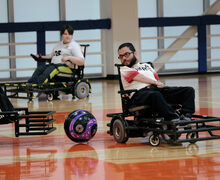SU to conduct rapid testing on symptomatic, infected students
Emily Steinberger | Photo Editor
Through rapid testing, students expect to receive results within 30 minutes without ever necessarily leaving the testing center.
The Daily Orange is a nonprofit newsroom that receives no funding from Syracuse University. Consider donating today to support our mission.
Syracuse University will conduct rapid coronavirus tests on symptomatic students throughout the fall semester, according to university officials.
With rapid testing, students can receive a coronavirus test within 30 minutes, said Sarah Scalese, vice president of communications at SU. The testing system is now “up and running,” she said.
As the university concludes its second round of pooled saliva testing this week, here’s an explainer on how rapid testing will work this semester, and which students are eligible to receive it:
How does rapid testing work?
Through rapid testing, students can provide a sample for a coronavirus test and expect to receive results within 30 minutes without ever necessarily leaving the testing center.
This is different from other types of testing SU has adopted, such as pooled saliva testing, which can include multiple stages and take several days to return results. The university said it planned to obtain five rapid test analyzers that can process samples and determine whether the students have the virus, according to SU’s reopening plan.
In its reopening plan, SU outlined rapid testing as a key factor in its ability to quickly identify and contain cases of the virus on campus.
“Capacity for immediate viral testing of all symptomatic students, faculty and staff — including the ability to rapidly test contacts and isolate infected individuals — is critical to the ability to resume residential activities in fall 2020,” the reopening plan reads.
The implementation of rapid tests comes as the university sees an uptick in student coronavirus infections, which officials have attributed to students leaving the area during Labor Day weekend. SU reported 30 active cases among SU students and employees in central New York on Friday, nine of which were new.
Overall, the university has seen a jump of 23 cases since Monday of last week. SU also announced Sunday that students on the eighth floor of Day Hall will have to quarantine as they await test results after three students on the floor tested positive.
Who can get a rapid test?
The university will conduct rapid testing on students who exhibit symptoms of the coronavirus and who have been in close contact with an infected individual. It is unclear how many students have utilized the university’s rapid testing system so far.
Students in a pooled saliva testing pool that shows traces of the coronavirus will also receive rapid testing. SU has conducted a second round of pooled testing over the past two weeks for the entire student body.
Upon arrival on campus this semester, SU students participated in pooled saliva testing grouped by housing assignment. The university announced plans in July to conduct rapid coronavirus tests at the Barnes Center at The Arch for students whose initial testing pool tested positive.
SU has not released any information about conducting rapid tests following its initial round of pooled testing. Vice Chancellor Mike Haynie, who has spearheaded SU’s coronavirus response, said in August that the pooled testing did not immediately turn up any COVID-19 cases.
What happens after a test?
SU will conduct coronavirus tests on symptomatic students at Flanagan Gym, according to SU’s reopening plan. Once the student receives the rapid coronavirus test, the university relocates them to the Sheraton Hotel to quarantine.
The university plans to relay positive test results through the Barnes Center to the Onondaga County Health Department.
If a student does test positive, they will hear from both SU and the Onondaga County Health Department. They will later move to isolation in the Sheraton or another facility on South Campus, where they will have to remain for at least ten days after they first presented symptoms.
Published on September 20, 2020 at 10:57 pm
Contact Abby: [email protected] | @abbyweiss_21





